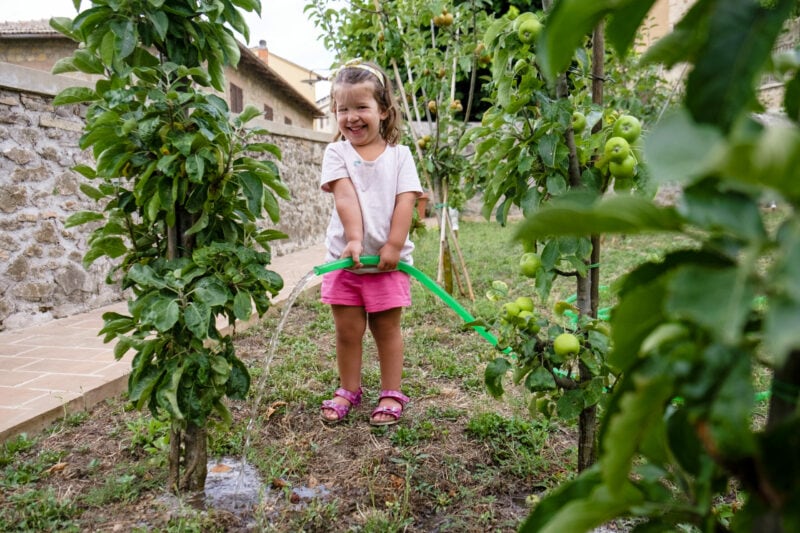Fruit tree considerations

If you haven’t planted fruit trees yet, hop to it. And, to give young trees the best start, remember the four Ws: where, welfare, water and weeds. Words Rachel Vogan
Where
When planting a new fruit tree, it is important to ensure it will get enough sunlight and protection from strong winds and frost in colder areas. In cold regions, it will be wise to plant later-flowering varieties to prevent frosts from affecting young fruit. Wind can cause many problems, with the main one being the loss of fruit.
Welfare
Fruit tree welfare is all about keeping the plants healthy. Keeping the fluids up to a fruit tree is important, as is keeping weeds away from the base of the plants. Nourishing the soil every year is recommended to replace the nutrients the soil has lost. When trees are young, the roots are still shallow and haven’t buried themselves deeply into the ground to seek out extra nutrients and more reliable water sources. Apply fruit fertiliser around the base of the trees in spring, water in well, and then add a layer of mulch around the base of the tree. Deal with pest and disease issues as soon as signs appear; this is super important in young trees. Get on top of nasties like mildew, codling moth and leaf curl at a young age to prevent crop failure. Regular spraying regimes help mitigate these problems.
Water
Fruiting plants require moisture to enable the fruits to form and establish. Older, established fruit trees have deep roots and can survive long periods without additional watering. But when trees are young, water is essential for fruit development. Aim to water deeply once a week or twice a month, rather than a splash every day or two. Deep watering encourages the roots to dig deeper into the ground to soak up the water.
Weeds
Aim to keep the areas under fruit trees clear of weeds. This helps the trees in several ways. Firstly, weeds often harbour insect pests and unwanted diseases, which can end up on the fruiting plant. Also, weeds take valuable moisture and nutrients from the ground before the tree can get them, and they look unsightly. Once the ground is bare, add a layer of mulch to prevent weeds from coming back. The mulch also insulates the soil at the same time, making it useful in many ways.
Stone fruit tips
Stone fruit is simply the best when picked ripe straight from the tree. With smaller hybrids now available for many stone fruits, small gardens may have room for a tree in a large tub or barrel. The added bonus to them being planted in containers is that they become portable and can move with you if you relocate.
Apricots
Some are self-fertile, meaning you only need one tree. Look for these self-fertile varieties: ‘Clutha Gold’, ‘Moorpark’, ‘Royal Rosa’, ‘Trevatt’ or ‘Tomcot’. Peaches All peaches are self-fertile, so you will not need a mate to pollinate flowers to produce fruit. ‘April White’ is a lovely white-fleshed variety. ‘Blackboy’ has a distinctive dark skin with mottled sweet flesh. ‘Red Haven’ is a popular red-skinned freestone variety.
Nectarines
Nectarines are self-fertile too. Consider planting a mix of earlyand late-season varieties to extend the harvest season. Early ‘Snow Queen’ has creamy-white sweet flesh and awesome flavour. Later-fruiting ‘Mabel’ is a little different as the foliage is dark purple and the fruit has purple skin. Late variety ‘Fantasia’ has red skin and juicy yellow flesh.
Plums & cherries
Both of these smaller stone fruits can produce a lot of fruit on one tree. Pollinators are required for some plum and cherry trees, so consider whether room for two trees is required. With cherries, frost can affect early-fruiting varieties, so choose types that fruit later for colder regions.
Birds are an issue for both plums and cherries. Consider investing in a covered space to grow cherries under to ensure you get to harvest the fruit before the birds. Nets can be used as well. Aim to keep cherry trees pruned to a smaller size if you plan to cover/net the trees each season.
Pip fruit tips
Apples, pears, medlars & quince Young branches will still be pliable; therefore, if you wish to train the stems to grow in a certain shape or way (or espalier them), now is the time to do it before the young fruit appears on the stems.
Apples are one of the easiest fruits to grow as the trees are hardy and require little care to produce a large crop. Pears can fruit well one year and not so well the next year, while medlars and quince are pretty reliable performers every season.
